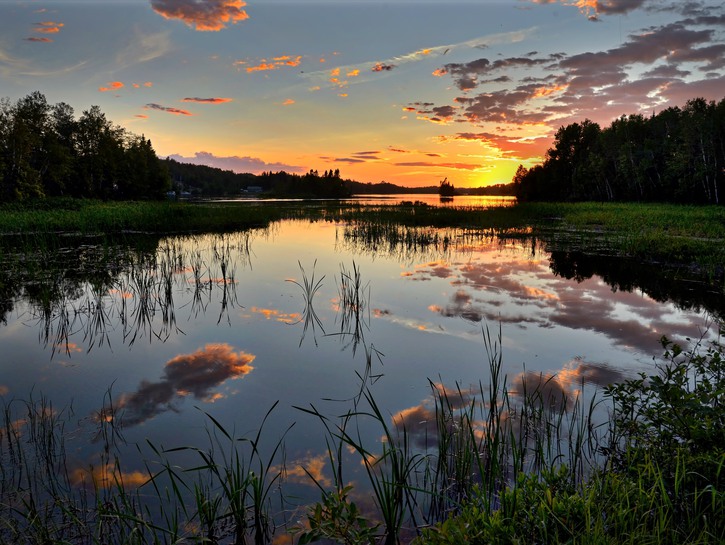
Stone ramparts, cobblestone streets, and everywhere the lilt of language imported by the province’s historic French founders: there’s no doubt that Quebec City is a world-class destination.
Videos by TravelAwaits
However, few visitors realize that the waters surrounding the metropolis — the islands, the lakes, the northern fjords — are responsible for the region’s personality. Long before the French arrived, this is where First Nations people hunted and fished year-round. When European traders and St. Lawrence River captains arrived, a partnership led to building booms and the emergence of villages and towns.
Today, those collaborations continue in the form of wildlife tours, indigenous menus, and maple specialties. Here’s a visitor’s guide to the endless wilderness that lies just outside Quebec City.
Island Times
Across the ramparts below the famous Frontenac Hotel in Quebec’s old city, your eye will be drawn to an island. Île d’Orléans is only a short ferry ride away, but it retains its rural feel — with farms, vineyards, maple groves, bakeries, and country manors.
You can visit by car, or join a tour to cross the only bridge. You’ll find wineries, chocolate shops, and orchards. Step behind the Café la Maison Smith shop and explore a maple grove. Blue tubes connect the trees that are used for tapping the thick syrup. The liquid needs refinement before eating, and inside the gift shop many options are offered for sampling.
Ready to spend a night under the stars? Go camping at the quiet shaded site Camping Orléans near the northern tip of the island.
The winery Vignoble du Mitan serves many ciders and fruit wines. The winter harvested Ice Cider is crisply sweet, and you can sip while admiring views across the St. Lawrence or into the Laurentian Forest.
Big Water
As you approach the Île d’Orléans, you can’t miss a powerful waterfall to the west. Believe it or not, the Sainte-Anne Falls are higher than Niagra Falls! Hike close, take a cable car, or cross the suspended bridge inside Montmorency Falls Park. Adrenaline seekers can get their thrills on the Air Canyon zip line or via ferratas (cliff climbing stabilized trails).
Get Rugged
Retreating glaciers at the end of the last Ice Age carved a steep and picturesque gorge eons ago. Today, the Saguenay Fjord is a nature lover’s paradise with trails, suspension bridges, lodges and boat excursions three hours northeast of Quebec City along the St. Lawrence. It’s a National Park, so there are plenty of opportunities to explore.
Tour vans, trucks, and cars queue at the ferry port at Baie Sainte Catherine. The ten-minute crossing is free for passengers and vehicles, but it’s not enough time to soak in the scenery! Scan the waters for glimpses of the whales that feed there year-round.

Fjords For Miles
The road climbs uphill from the water to a lookout point above the red roofs of Tadoussac and across the confluence of the St. Lawrence River and the Saguenay Fjord. Biologists and scientists have been studying the region’s marine animals in an effort to increase their numbers. Stop in at the Marine Mammal Interpretation Centre with your questions and marvel at the Centre’s impressive whale skeletons and artifacts. You’ll leave with a new appreciation for these gentle giants of the deep.
Weather permitting, as you pass the harbor in town, take a brief walk on the raised planks of Le Parc du Saguenay trail to Pointe-de-I’islet lookout. It’s easy to imagine First Nations people fishing from the boulders and their summer camps. They too thrilled to spy the white humps of feeding Belugas and sea lions playing in the chilly waters below.
Whale Watching
You can’t get this close and forgo a chance to see the mighty whales by boat. The Croisieres AML company has massive yellow inflatables that hold up to 60 passengers. Once registered, passengers suit up in waterproof gear. In cold weather, the company ends the two-and-a-half hour tours with complimentary chicken soup! During the summer the sightings continue without teeth-chattering. The ships nose up to an abandoned lighthouse, cruise past sea lions, and end with a short trip up river to waterfalls before returning to port in Quebec City.
Paddler’s Paradise
There are several kayaking options in the milder months. Twelve miles from town, the seaport of Anse du Roche hosts a large lot, gazebo and picnic tables. There’s a boat ramp for sport fishing and pleasure cruisers. It’s quite a spot to catch the sunset, as the views across the waters to the mountains are unparalleled.
Wolf Hugs, Bison And Baby Bunnies
In the Sacre-Coeur hillside outside of Tadoussac, there’s a family farm that welcomes visitors. Ferme Cinq Etoiles adopts injured or abandoned animals from across the region. Each morning here begins with eggs and sausage made on the premises. After breakfast, visitors are welcome to help with feedings in the ‘hen-house’ where hungry barn-yard animals are waiting.
The Ferme Cinq Etoiles (Five-star farm) is named for the family’s children; several of them work the land, help at mealtime or with tours. A pen of Bison sits on a rise near the bunkhouse where large two-bedroom apartments open onto a veranda with views across the valley. There are chalets, yurts, and trapper’s log-cabin as well.
In winter, the farm organizes ATV rides, dog-sledding, and maple toffee lessons. Come spring, visitors help as freshly-harvested maple syrup cooks in the Sugar Shack before being poured onto fresh snow, rolled, and slurped.
In the warmer months, the candy making comes indoors as the heated farm-harvested syrup is poured on a bed of shaved ice.
Quebec City’s urban delights are certainly tempting but any trip to the region is incomplete without a walk on the wild side!

Photo: Elaine J. Masters
